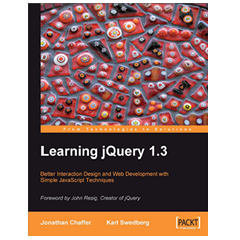jQuery has taken the development world by storm. It has provided an easy to use, yet stunningly powerful JavaScript library available to anyone and everyone.
Now on version 1.3, the project (if it can still be called one) has grown amazingly from the initial development phase in August 2005. An ever-increasing community and developers creating plugins and components for the library further enhance the features and continue to push back the boundaries and benefits of using jQuery.
I received a copy of the book ‘Learning jQuery 1.3’, written by Jonathan Chaffer and Karl Swedberg, published by Packt Publishing, and was very impressed with the publication. The authors clearly have a firm understanding of jQuery, and the book is very well written.
This book, in my opinion, further enhances an already amazing JavaScript library, and makes sure that the reader understands the code and available options through the use of detailed explanations and fantastic real-world examples.
The subjects covered in each chapter are:
Chapter 1
The primary chapter in the publication provides an insight into the history of the development of jQuery, and more importantly the installation and basic syntax to use the library. A fine example of CSS behaviours is shown. Already, after reading only a few pages, you can see how easy it is to write and develop using jQuery.
Chapter 2
The second chapter introduces the reader to working with the Document Object Model, how to create and access elements, CSS selectors and styling items, DOM traversal and creating custom selectors.
Chapter 3
Events are the topic in this chapter, and go into a lot of detail. The timing of code execution, working alongside other JavaScript libraries, event targets and handlers, keyboard events and user integration are amongst the items covered. The chapter also includes and discusses a style switcher, showing the ease and simplicity of creating useful functionality.
Chapter 4
Chapter 4 covers effects, ranging from hide/show functions to animating multiple properties and creating custom animations. jQuery is able to deliver fantastic effects and transitions, and with the help of this chapter, the reader can achieve fantastic results.
Chapter 5
This chapter covers DOM manipulation in more detail. It discusses and delves further into the jQuery $() factory function (which was discussed in Chapter 2), and introduces further aspects for DOM manipulation including moving, appending and copying elements.
Chapter 6
I have no doubt that this chapter would be read from cover to cover, as it discusses AJAX and the methods available to create AJAX calls using jQuery, including GET and POST requests, loading XML and using JSONP to retrieve remote data.
Chapter 7
Clear out your old tables, results pages and stuffy reports and increase the usability and functionality by reading this chapter, Table Manipulation, which outlines sorting, filtering, adding alternate styles to rows, tooltips, sections and pagination. These are certainly tools we all use/need at some point during our development careers or within projects, and this chapter will guide you through exactly how to achieve them.
Chapter 8
Forms and form validation are covered in this chapter, as well as styling elements and auto-complete functions. All of these points are shown in practical use on a shopping cart basket/checkout page, which also uses the chapter’s work on numeric validation and calculations. A great chapter covering a valuable real-world example.
Chapter 9
Creating dynamic, eye-catching widgets or components is truly a joy with jQuery. I found this whilst developing my gallerificPlus jQuery plugin. This chapter, ‘Shufflers and Rotators’ guides the reader through a working example of creating a fantastic rotating image gallery, complete with sliding animation and user-interactivity. This is a great chapter covering a range of techniques that most developers would find incredibly helpful.
Chapter 10
This chapter deals with plugins, integrating them into your code, and also discusses the jQuery UI. Effects, widgets and a list of recommended plugins are provided to ensure that you get the most out of the fantastic jQuery community and open-source plugins available.
Chapter 11
Chapter 10 wets the appetite, and lines you up for Chapter 11, ‘Developing Plugins’. This incredibly informative chapter explains and outlines everything you need to know to create your own killer jQuery plugins. That great code you had stored can now be unleashed and thrown back into the wild for the rest of the world to use once you turned it into a plugin.
The appendix and remaining pages in the book provide the user with great links to resources, blogs, script documentation and development tools. Everything you need to complete your jQuery development is here.
I would highly recommend this book to anyone, and think that developers and front-end designers in particular will certainly benefit from reading this.
For 421 content-filled pages, you can’t go wrong.
Book details
Title: Learning jQuery 1.3
Authors: Jonathan Chaffer and Karl Swedberg
Published by Packt Publishing


